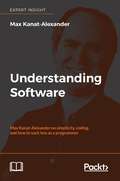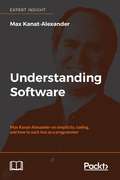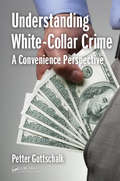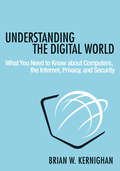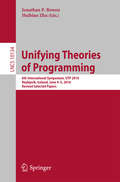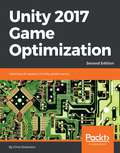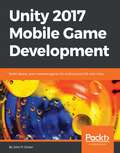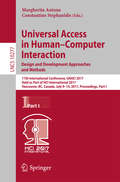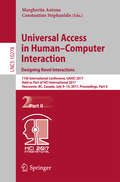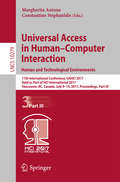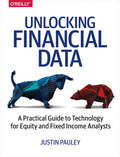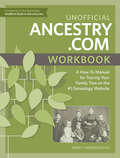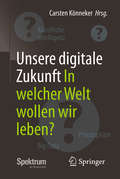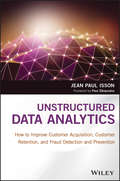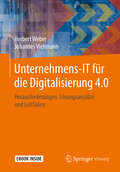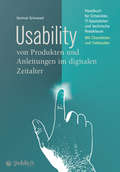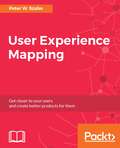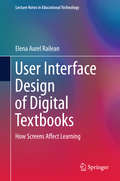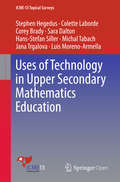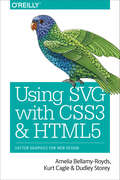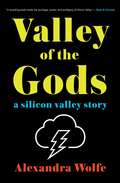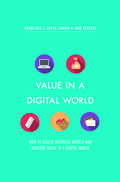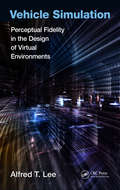- Table View
- List View
Understanding Software
by Max Kanat-AlexanderSoftware legend Max Kanat-Alexander shows you how to succeed as a developer by embracing simplicity, with forty-three essays that will help you really understand the software you work with. About This Book • Read and enjoy the superlative writing and insights of the legendary Max Kanat-Alexander • Learn and reflect with Max on how to bring simplicity to your software design principles • Discover the secrets of rockstar programmers and how to also just suck less as a programmer Who This Book Is For Understanding Software is for every programmer, or anyone who works with programmers. If life is feeling more complex than it should be, and you need to touch base with some clear thinking again, this book is for you. If you need some inspiration and a reminder of how to approach your work as a programmer by embracing some simplicity in your work again, this book is for you. If you're one of Max's followers already, this book is a collection of Max's thoughts selected and curated for you to enjoy and reflect on. If you're new to Max's work, and ready to connect with the power of simplicity again, this book is for you! What You Will Learn • See how to bring simplicity and success to your programming world • Clues to complexity - and how to build excellent software • Simplicity and software design • Principles for programmers • The secrets of rockstar programmers • Max's views and interpretation of the Software industry • Why Programmers suck and how to suck less as a programmer • Software design in two sentences • What is a bug? Go deep into debugging In Detail In Understanding Software, Max Kanat-Alexander, Technical Lead for Code Health at Google, shows you how to bring simplicity back to computer programming. Max explains to you why programmers suck, and how to suck less as a programmer. There's just too much complex stuff in the world. Complex stuff can't be used, and it breaks too easily. Complexity is stupid. Simplicity is smart. Understanding Software covers many areas of programming, from how to write simple code to profound insights into programming, and then how to suck less at what you do! You'll discover the problems with software complexity, the root of its causes, and how to use simplicity to create great software. You'll examine debugging like you've never done before, and how to get a handle on being happy while working in teams. Max brings a selection of carefully crafted essays, thoughts, and advice about working and succeeding in the software industry, from his legendary blog Code Simplicity. Max has crafted forty-three essays which have the power to help you avoid complexity and embrace simplicity, so you can be a happier and more successful developer. Max's technical knowledge, insight, and kindness, has earned him a status as a code guru, and his ideas will inspire you and help refresh your approach to the challenges of being a developer. Style and approach Understanding Software is a new selection of carefully chosen and crafted essays from Max Kanat-Alexander's legendary blog call Code Simplicity. Max's writing and thoughts are great to sit and read cover to cover, or if you prefer you can drop in and see what you discover new every single time!
Understanding Software
by Max Kanat-AlexanderSoftware legend Max Kanat-Alexander shows you how to succeed as a developer by embracing simplicity, with forty-three essays that will help you really understand the software you work with. About This Book Read and enjoy the superlative writing and insights of the legendary Max Kanat-Alexander Learn and reflect with Max on how to bring simplicity to your software design principles Discover the secrets of rockstar programmers and how to also just suck less as a programmer Who This Book Is For Understanding Software is for every programmer, or anyone who works with programmers. If life is feeling more complex than it should be, and you need to touch base with some clear thinking again, this book is for you. If you need some inspiration and a reminder of how to approach your work as a programmer by embracing some simplicity in your work again, this book is for you. If you're one of Max's followers already, this book is a collection of Max's thoughts selected and curated for you to enjoy and reflect on. If you're new to Max's work, and ready to connect with the power of simplicity again, this book is for you! What You Will Learn See how to bring simplicity and success to your programming world Clues to complexity - and how to build excellent software Simplicity and software design Principles for programmers The secrets of rockstar programmers Max's views and interpretation of the Software industry Why Programmers suck and how to suck less as a programmer Software design in two sentences What is a bug? Go deep into debugging In Detail In Understanding Software, Max Kanat-Alexander, Technical Lead for Code Health at Google, shows you how to bring simplicity back to computer programming. Max explains to you why programmers suck, and how to suck less as a programmer. There's just too much complex stuff in the world. Complex stuff can't be used, and it breaks too easily. Complexity is stupid. Simplicity is smart. Understanding Software covers many areas of programming, from how to write simple code to profound insights into programming, and then how to suck less at what you do! You'll discover the problems with software complexity, the root of its causes, and how to use simplicity to create great software. You'll examine debugging like you've never done before, and how to get a handle on being happy while working in teams. Max brings a selection of carefully crafted essays, thoughts, and advice about working and succeeding in the software industry, from his legendary blog Code Simplicity. Max has crafted forty-three essays which have the power to help you avoid complexity and embrace simplicity, so you can be a happier and more successful developer. Max's technical knowledge, insight, and kindness, has earned him code guru status, and his ideas will inspire you and help refresh your approach to the challenges of being a developer. Style and approach Understanding Software is a new selection of carefully chosen and crafted essays from Max Kanat-Alexander's legendary blog call Code Simplicity. Max's writing and thoughts are great to sit and read cover to cover, or if you prefer you can drop in and see what you discover new every single time!
Understanding White-Collar Crime: A Convenience Perspective
by Petter GottschalkUnderstanding White-Collar Crime develops the concept of convenience as the main explanation for crime occurrence. Examining all three dimensions of crime—economic, organizational, and behavioral—the book argues that when white-collar crime becomes less convenient, crime rates will go down. By applying convenience theory to an empirical sample of convicted white-collar criminals, the text teaches criminal justice students and ethics and compliance practitioners to identify and understand how opportunity affects real-world criminal situations. Internal investigations of white-collar crime are discussed, and corporate social responsibility against white-collar crime is emphasized. Understanding White-Collar Crime: A Convenience Perspective examines not only the theories behind white-collar crime, but also explores methods used in criminal justice investigations into corporate fraud, and emphasizes the importance of corporate social responsibility in reducing crimes of this nature. Criminal justice students and practitioners should not miss this close look into the world of white-collar crime.
Understanding the Digital World: What You Need to Know about Computers, the Internet, Privacy, and Security
by Brian W. KernighanComputers are everywhere. Some of them are highly visible, in laptops, tablets, cell phones, and smart watches. But most are invisible, like those in appliances, cars, medical equipment, transportation systems, power grids, and weapons. We never see the myriad computers that quietly collect, share, and sometimes leak vast amounts of personal data about us. Through computers, governments and companies increasingly monitor what we do. Social networks and advertisers know far more about us than we should be comfortable with, using information we freely give them. Criminals have all-too-easy access to our data. Do we truly understand the power of computers in our world?Understanding the Digital World explains how computer hardware, software, networks, and systems work. Topics include how computers are built and how they compute; what programming is and why it is difficult; how the Internet and the web operate; and how all of these affect our security, privacy, property, and other important social, political, and economic issues. This book also touches on fundamental ideas from computer science and some of the inherent limitations of computers. It includes numerous color illustrations, notes on sources for further exploration, and a glossary to explain technical terms and buzzwords.Understanding the Digital World is a must-read for all who want to know more about computers and communications. It explains, precisely and carefully, not only how they operate but also how they influence our daily lives, in terms anyone can understand, no matter what their experience and knowledge of technology.
Unifying Theories of Programming
by Jonathan P. Bowen Huibiao ZhuThis book constitutes the refereed proceedings of the 6th International Symposium on Unifying Theories of Programming, UTP 2016, held in Reykjavik, Iceland, in June 2016, in conjunction with the 12th International Conference on Integrated Formal Methods, iFM 2016. The 8 revised full papers presented were carefully reviewed and selected from 10 submissions. They deal with the fundamental problem of combination of formal notations and theories of programming that define in various different ways many common notions, such as abstraction refinement, choice, termination, feasibility, locality, concurrency, and communication. They also show that despite many differences, such theories may be unified in a way that greatly facilitates their study and comparison.
Unity 2017 Game Optimization - Second Edition
by Chris DickinsonMaster a series of performance-enhancing coding techniques and methods that help them improve the performance of their Unity3D applications About This Book • Discover features and techniques to optimize Unity Engine's CPU cycles, memory usage, and the GPU throughput of any application • Explore multiple techniques to solve performance issues with your VR projects • Learn the best practices for project organization to save time through an improved workflow Who This Book Is For This book is intended for intermediate and advanced Unity developers who have experience with most of Unity's feature-set, and who want to maximize the performance of their game. Familiarity with the C# language will be needed. What You Will Learn • Use the Unity Profiler to find bottlenecks anywhere in your application, and discover how to resolve them • Implement best practices for C# scripting to avoid common pitfalls • Develop a solid understanding of the rendering pipeline, and maximize its performance by reducing draw calls and avoiding fill rate bottlenecks • Enhance shaders in a way that is accessible to most developers, optimizing them through subtle yet effective performance tweaks • Keep your scenes as dynamic as possible by making the most of the Physics engine • Organize, filter, and compress your art assets to maximize performance while maintaining high quality • Discover different kinds of performance problems that are critical for VR projects and how to tackle them • Use the Mono Framework and C# to implement low-level enhancements that maximize memory usage and avoid garbage collection • Get to know the best practices for project organization to save time through an improved workflow In Detail Unity is an awesome game development engine. Through its massive feature-set and ease-of-use, Unity helps put some of the best processing and rendering technology in the hands of hobbyists and professionals alike. This book shows you how to make your games fly with the recent version of Unity 2017, and demonstrates that high performance does not need to be limited to games with the biggest teams and budgets. Since nothing turns gamers away from a game faster than a poor user-experience, the book starts by explaining how to use the Unity Profiler to detect problems. You will learn how to use stopwatches, timers and logging methods to diagnose the problem. You will then explore techniques to improve performance through better programming practices. Moving on, you will then learn about Unity's built-in batching processes; when they can be used to improve performance, and their limitations. Next, you will import your art assets using minimal space, CPU and memory at runtime, and discover some underused features and approaches for managing asset data. You will also improve graphics, particle system and shader performance with a series of tips and tricks to make the most of GPU parallel processing. You will then delve into the fundamental layers of the Unity3D engine to discuss some issues that may be difficult to understand without a strong knowledge of its inner-workings. The book also introduces you to the critical performance problems for VR projects and how to tackle them. By the end of the book, you will have learned to improve the development workflow by properly organizing assets and ways to instantiate assets as quickly and waste-free as possible via object pooling. Style and approach This practical book will help readers understand the essentials of the Unity3D engine and how to build games while improving the performance of their applications.
Unity 2017 Mobile Game Development
by John P. DoranLearn to create, publish and monetize your mobile games with the latest Unity 2017 tool-set easily for Android and iOS About This Book • One-stop solution to becoming proficient in mobile game development using Unity 2017 • Port your Unity games to popular platforms such as iOS and Android • Unleash the power of C# scripting to create realistic gameplay and animations in Unity 2017. Who This Book Is For If you are a game developer and want to build mobile games for iOS and Android, then this is the book for you. Previous knowledge of C# and Unity is helpful, but not required. What You Will Learn • Use Unity to build an endless runner game • Set up and deploy a project to a mobile device • Create interesting gameplay elements using inputs from your mobile device • Monetize your game projects with Unity ads and in-app purchases • Design UI elements that can be used well in Landscape and Portrait mode at different resolutions, supporting phones, tablets, and PCs. • How to submit your game to the iOS and Android app stores In Detail Unity has established itself as an overpowering force for developing mobile games. If you love mobile games and want to learn how to make them but have no idea where to begin, then this book is just what you need. This book takes a clear, step-by-step approach to building an endless runner game using Unity with plenty of examples on how to create a game that is uniquely your own. Starting from scratch, you will build, set up, and deploy a simple game to a mobile device. You will learn to add touch gestures and design UI elements that can be used in both landscape and portrait mode at different resolutions. You will explore the best ways to monetize your game projects using Unity Ads and in-app purchases before you share your game information on social networks. Next, using Unity's analytics tools you will be able to make your game better by gaining insights into how players like and use your game. Finally, you'll learn how to publish your game on the iOS and Android App Stores for the world to see and play along. Style and approach This book takes a clear, step-by-step approach for Unity game developers to explore everything needed to develop mobile games with Unity.
Universal Access in Human–Computer Interaction. Design and Development Approaches and Methods
by Margherita Antona Constantine StephanidisThe three-volume set LNCS 10277-10279 constitutes the refereed proceedings of the11th International Conference on Universal Access in Human-Computer Interaction, UAHCI 2017, held as part of the 19th International Conference on Human-Computer Interaction, HCII 2017, in Vancouver, BC, Canada in July 2017, jointly with 14 other thematically similar conferences. The total of 1228 papers presented at the HCII 2017 conferences were carefully reviewed and selected from 4340 submissions. The papers included in the three UAHCI 2017 volumes address the following major topics: Design for All Methods and Practice; Accessibility and Usability Guidelines and Evaluation; User and Context Modelling and Monitoring and Interaction Adaptation; Design for Children; Sign Language Processing; Universal Access to Virtual and Augmented Reality; Non Visual and Tactile Interaction; Gesture and Gaze-Based Interaction; Universal Access to Health and Rehabilitation; Universal Access to Education and Learning; Universal Access to Mobility; Universal Access to Information and Media; and Design for Quality of Life Technologies.
Universal Access in Human–Computer Interaction. Designing Novel Interactions
by Margherita Antona Constantine StephanidisThe three-volume set LNCS 10277-10279 constitutes the refereed proceedings of the11th International Conference on Universal Access in Human-Computer Interaction, UAHCI 2017, held as part of the 19th International Conference on Human-Computer Interaction, HCII 2017, in Vancouver, BC, Canada in July 2017, jointly with 14 other thematically similar conferences. The total of 1228 papers presented at the HCII 2017 conferences were carefully reviewed and selected from 4340 submissions. The papers included in the three UAHCI 2017 volumes address the following major topics: Design for All Methods and Practice; Accessibility and Usability Guidelines and Evaluation; User and Context Modelling and Monitoring and Interaction Adaptation; Design for Children; Sign Language Processing; Universal Access to Virtual and Augmented Reality; Non Visual and Tactile Interaction; Gesture and Gaze-Based Interaction; Universal Access to Health and Rehabilitation; Universal Access to Education and Learning; Universal Access to Mobility; Universal Access to Information and Media; and Design for Quality of Life Technologies.
Universal Access in Human–Computer Interaction. Human and Technological Environments
by Margherita Antona Constantine StephanidisThe three-volume set LNCS 10277-10279 constitutes the refereed proceedings of the11th International Conference on Universal Access in Human-Computer Interaction, UAHCI 2017, held as part of the 19th International Conference on Human-Computer Interaction, HCII 2017, in Vancouver, BC, Canada in July 2017, jointly with 14 other thematically similar conferences. The total of 1228 papers presented at the HCII 2017 conferences were carefully reviewed and selected from 4340 submissions. The papers included in the three UAHCI 2017 volumes address the following major topics: Design for All Methods and Practice; Accessibility and Usability Guidelines and Evaluation; User and Context Modelling and Monitoring and Interaction Adaptation; Design for Children; Sign Language Processing; Universal Access to Virtual and Augmented Reality; Non Visual and Tactile Interaction; Gesture and Gaze-Based Interaction; Universal Access to Health and Rehabilitation; Universal Access to Education and Learning; Universal Access to Mobility; Universal Access to Information and Media; and Design for Quality of Life Technologies.
Unlocking Financial Data: A Practical Guide to Technology for Equity and Fixed Income Analysts
by Justin PauleyInvestors recognize that technology is a powerful tool for obtaining and interpreting financial data that could give them the one thing everyone on Wall Street wants: an edge. Yet, many don’t realize that you don’t need to be a programmer to access behind-the-scenes financial information from Bloomberg, IHS Markit, or other systems found at most banks and investment firms.This practical guide teaches analysts a useful subset of Excel skills that will enable them to access and interpret financial information—without any prior programming experience. This book will show analysts, step-by-step, how to quickly produce professional reports that combine their views with Bloomberg or Markit data including historical financials, comparative analysis, and relative value. For portfolio managers, this book demonstrates how to create professional summary reports that contain a high-level view of a portfolio’s performance, growth, risk-adjusted return, and composition. If you are a programmer, this book also contains a parallel path that covers the same topics using C#.Topics include:Access additional data that isn’t visible on Bloomberg screensCreate tables containing corporate data that makes it possible to compare multiple companies, bonds, or loans side-by- sideBuild one-page analytic (“Tear Sheet”) reports for individual companies that incorporates important financials, custom notes, relative value comparison of the company to its peers, and price trends with research analyst targetsBuild two-page portfolio summary report that contains a high-level view of the portfolio’s performance, growth, risk-adjusted return, and compositionExplore daily prices and facility information for most of the tradable corporate bond and loan marketDetermine the relationship between two securities (or index) using correlation and regressionCompare each security’s performance to a cohort made of up of securities with similar risk and return characteristicsMeasure portfolio risk-adjusted return by calculating variance, standard deviation, and Sharpe ratioUse Markit data to identify meaningful trends in prices, new issue spreads, and refinancings
Unofficial Ancestry.com Workbook: A How-To Manual for Tracing Your Family Tree on the #1 Genealogy Website
by Nancy HendricksonA How-To Manual for Tracing Your Family Tree on the #1 Genealogy Website
Unplugged
by Steve AntonyFrom the creator of the bestselling Mr. Panda series comes an amusing picture book about the fun you can have when you unplug.Meet Blip. Blip loves being plugged into her computer. When a blackout occurs, Blip trips over her wire and tumbles outside. Suddenly, Blip's gray world is filled with color and excitement. She plays with her new friends and has adventures all day long. When Blip finally returns home, she realizes that the world can be even brighter once you unplug.
Unsere digitale Zukunft
by Carsten KönnekerDroht die ferngesteuerte Gesellschaft?Dieses Buch greift das weithin diskutierte, zum Jahreswechsel 2015/16 veröffentlichte „Digital-Manifest“ auf und führt die Debatte entlang vielfältiger Themenlinien weiter. Es geht hierbei um nicht weniger als unsere – digitale – Zukunft: Welche Chancen eröffnen künstliche Intelligenz und digitale Technologien, welche Risiken und ethische Herausforderungen bergen sie? Wie schützen wir unsere Daten und die Privatsphäre? Wie sichern wir individuelle Freiheit und Demokratie vor Gefahren der digitalen Verhaltenssteuerung? Wie sollen selbstfahrende Autos, Roboter und autonome Agenten unser Leben prägen? Als Gesellschaft und als Individuen müssen wir uns mit verschiedenen Projektionen in die Zukunft auseinandersetzen. Dabei sollten wir die Einschätzungen führender Experten in der Zusammenschau vernehmen und diskutieren. Den kritischen Dialog zu beflügeln, ist das Ziel dieses Sammelbands mit den wichtigsten Beiträgen namhafter Wissenschaftler aus Spektrum der Wissenschaft, Spektrum – Die Woche und Spektrum.de.
Unstructured Data Analytics: How to Improve Customer Acquisition, Customer Retention, and Fraud Detection and Prevention
by Jean Paul IssonTurn unstructured data into valuable business insight Unstructured Data Analytics provides an accessible, non-technical introduction to the analysis of unstructured data. Written by global experts in the analytics space, this book presents unstructured data analysis (UDA) concepts in a practical way, highlighting the broad scope of applications across industries, companies, and business functions. The discussion covers key aspects of UDA implementation, beginning with an explanation of the data and the information it provides, then moving into a holistic framework for implementation. Case studies show how real-world companies are leveraging UDA in security and customer management, and provide clear examples of both traditional business applications and newer, more innovative practices. Roughly 80 percent of today's data is unstructured in the form of emails, chats, social media, audio, and video. These data assets contain a wealth of valuable information that can be used to great advantage, but accessing that data in a meaningful way remains a challenge for many companies. This book provides the baseline knowledge and the practical understanding companies need to put this data to work. Supported by research with several industry leaders and packed with frontline stories from leading organizations such as Google, Amazon, Spotify, LinkedIn, Pfizer Manulife, AXA, Monster Worldwide, Under Armour, the Houston Rockets, DELL, IBM, and SAS Institute, this book provide a framework for building and implementing a successful UDA center of excellence. You will learn: How to increase Customer Acquisition and Customer Retention with UDA The Power of UDA for Fraud Detection and Prevention The Power of UDA in Human Capital Management & Human Resource The Power of UDA in Health Care and Medical Research The Power of UDA in National Security The Power of UDA in Legal Services The Power of UDA for product development The Power of UDA in Sports The future of UDA From small businesses to large multinational organizations, unstructured data provides the opportunity to gain consumer information straight from the source. Data is only as valuable as it is useful, and a robust, effective UDA strategy is the first step toward gaining the full advantage. Unstructured Data Analytics lays this space open for examination, and provides a solid framework for beginning meaningful analysis.
Unternehmens-IT für die Digitalisierung 4.0
by Herbert Weber Johannes ViehmannMit dem Praxisbuch bereiten die Autoren Orientierungswissen für die Modernisierung der Informations- und Kommunikations-Infrastrukturen für die Unternehmens-IT der Zukunft auf. Dazu werden die verfügbaren, schon praxisreifen neuen Technologien und deren Nutzung in ihren jeweiligen Anwendungen, aber auch Ergebnisse der Forschung und der Stand der Forschung erläutert sowie Leitfäden zur digitalen Transformation angeboten.
Usability von Produkten und Anleitungen im digitalen Zeitalter: Handbuch für Entwickler, IT-Spezialisten und technische Redakteure
by Gertrud GrünwiedTechnische Produkte können nur erfolgreich sein, wenn die Gebrauchstauglichkeit, die Usability, frühzeitig im Entwicklungsprozess geplant und in allen Produktphasen verankert wird. Dies betrifft smarte Geräte, Softwareprodukte, Webanwendungen und Apps genauso wie komplexe und umfangreich dokumentierte Maschinen, Fahrzeuge und Systeme. In ihrem Buch vermittelt Gertrud Grünwied eine ganzheitliche Sicht auf intuitiv bedienbare Produkte und deren Anleitungen. Sie bietet das relevante Know-how zu User-Centered Design und eine Übersicht zur Auswahl von Usability-Methoden. Usability-Maßnahmen beschreibt sie schrittweise von der Planung, der Durchführung und Auswertung bis zur Optimierung von Produkt und Anleitung. Der Praxisteil präsentiert Fallstudien für Anleitungen mit und ohne Produkt sowie für eine Dienste-App im Internet, außerdem eine Betrachtung zu Kosten, Nutzen und Implementierungszeitpunkt von Usability-Methoden. Die dargestellten Usability-Maßnahmen erstrecken sich nicht nur auf das technische Produkt selbst, sondern auch auf die Nutzungssituation und die smarte Benutzerinformation, zum Beispiel das Nachschlagen in der Bedienungsanleitung zur Fehlerbehebung, Dokumentations-Apps zum Kennenlernen von Systemfunktionen oder das Üben und Lernen anhand einer Produktsimulation per Video-Tutorial oder Animation. Damit richtet sich das Buch an alle Mitarbeiter produzierender Unternehmen und ihrer Dienstleister, die an Usability-Aspekten beteiligt sind - Produktmanager, Entwickler, IT-Spezialisten, Designer, Technische Redakteure und Mitarbeiter in Schulung und Service, aber auch an Studierende der Informatik und Ingenieurwissenschaften einschließlich Technischer Redaktion und Kommunikation. Inhalt: Anforderungen an Usability von Produkten und Anleitungen "4.0" - Prozesse und Planung - Nutzer- und Nutzungsforschung - Gestaltung - Evaluation - Anwenden der Methoden und ihre Wirtschaftlichkeit - Fallstudien - Software-Tools und Normen
User Experience Mapping
by Peter W. SzaboUnderstand your users, gain strategic insights, and make your product development more efficient with user experience mapping About This Book • Detailed guidance on the major types of User Experience Maps. • Learn to gain strategic insights and improve communication with stakeholders . • Get an idea on creating wireflows, mental model maps, ecosystem maps and solution maps Who This Book Is For This book is for Product Manager, Service Managers and Designers who are keen on learning the user experience mapping techniques. What You Will Learn • Create and understand all common user experience map types. • Use lab or remote user research to create maps and understand users better. • Design behavioral change and represent it visually. • Create 4D user experience maps, the “ultimate UX deliverable”. • Capture many levels of interaction in a holistic view. • Use experience mapping in an agile team, and learn how maps help in communicating within the team and with stakeholders. • Become more user focused and help your organisation become user-centric. In Detail Do you want to create better products and innovative solutions? User Experience Maps will help you understand users, gain strategic insights and improve communication with stakeholders. Maps can also champion user-centricity within the organisation. Two advanced mapping techniques will be revealed for the first time in print, the behavioural change map and the 4D UX map. You will also explore user story maps, task models and journey maps. You will create wireflows, mental model maps, ecosystem maps and solution maps. In this book, the author will show you how to use insights from real users to create and improve your maps and your product. The book describes each major User Experience map type in detail. Starting with simple techniques based on sticky notes moving to more complex map types. In each chapter, you will solve a real-world problem with a map. The book contains detailed, beginner level tutorials on creating maps using different software products, including Adobe Illustrator, Balsamiq Mockups, Axure RP or Microsoft Word. Even if you don't have access to any of those, each map type can also be drawn with pen and paper. Beyond creating maps, the book will also showcase communication techniques and workshop ideas. Although the book is not intended to be a comprehensive guide to modern user experience or product management, its novel ideas can help you create better solutions. You will also learn about the Kaizen-UX management framework, developed by the author, now used by many agencies and in-house UX teams in Europe and beyond. Buying this map will give you hundreds of hours worth of user experience knowledge, from one of the world's leading UX consultants. It will change your users' world for the better. If you are still not convinced, we have hidden some cat drawings in it, just in case. Style and approach An easy to understand guide, filled with real world use cases on how to plan, prioritize and visualize your project on customer experience
User Interface Design of Digital Textbooks
by Elena Aurel RaileanThis book is a synthesis of the complex interdependencies between user interface design of digital screen and learning process. It is analyzed the impact of digital revolution on learning, phases of digital textbooks use and development; specific features of educational system & learning environment; psycho-pedagogical characteristics of XXI students; user interface design topology; user interface design features of digital textbooks in accordance with human thinking paradigms; critical thinking of user interfaces and content (linear, systems, global and metasystems design approach). One special chapter describes innovative organizational forms of learning with digital textbooks. Metasystems learning design of digital textbooks will be of particular interest to the readers because this is an innovative approach of learning design, which proved the experimental data of the instructional dynamic and flexible strategy. It proved the practical application of didactical model of digital textbooks for chemistry and mathematics. The main benefits for reader refers on understanding the applicability of metasystems learning design for digital textbook use and development, in particular for STEM education. It takes more than analysis to help readers overcome the impact of user interface design of digital textbook on learning outcomes.
Uses of Technology in Upper Secondary Mathematics Education
by Hans-Stefan Siller Stephen Hegedus Colette Laborde Corey Brady Sara Dalton Michal Tabach Jana Trgalova Luis Moreno-ArmellaThis survey addresses the use of technology in upper secondary mathematics education from four points of view: theoretical analysis of epistemological and cognitive aspects of activity in new technology mediated learning environments, the changes brought by technology in the interactions between environment, students and teachers, the interrelations between mathematical activities and technology, skills and competencies that must be developed in teacher education. Research shows that the use of some technologies may deeply change the solving processes and contribute to impact the learning processes. The questions are which technologies to choose for which purposes, and how to integrate them, so as to maximize all students' agency. In particular the role of the teacher in classrooms and the content of teacher education programs are critical for taking full advantage of technology in teaching practice.
Using SVG with CSS3 and HTML5: Vector Graphics for Web Design
by Amelia Bellamy-Royds Kurt Cagle Dudley StoreyUsing Scalable Vector Graphics (SVG) for illustrations only scratches the surface of this format’s potential on the web. With this practical guide, you’ll learn how to use SVG not only for illustrations but also as graphical documents that you can integrate into complex HTML5 web pages, and style with custom CSS. Web developers will discover ways to adapt designs by adding data based graphics, dynamic styles, interaction, or animation.Divided into five parts, this book includes:SVG on the web: Understand how SVG works with HTML, CSS, and JavaScript to define graphicsDrawing with markup: Learn the vector language of x and y coordinates that let SVG create basic and custom shapesPutting graphics in their place: Use the coordinate system to draw SVG shapes and text at different scales and positionsArtistic touches: Explore how color is used, how strokes are created and manipulated, and how graphical effects like filters, clipping, and masking are appliedSVG as an application: Make your graphic more accessible to humans and computers, and learn how to make it interactive or animated
Valley of the Gods: A Silicon Valley Story
by Alexandra WolfeIn a riveting, hilarious account, reporter Alexandra Wolfe exposes a world that is not flat but bubbling—the men and women of Silicon Valley, whose hubris and ambition are changing the world.Each year, young people from around the world go to Silicon Valley to hatch an idea, start a company, strike it rich, and become powerful and famous. In The Valley of the Gods, Wolfe follows three of these upstarts who have “stopped out” of college and real life to live and work in Silicon Valley in the hopes of becoming the next Mark Zuckerberg or Elon Musk. No one has yet documented the battle for the brightest kids, kids whose goals are no less than making billions of dollars—and the fight they wage in turn to make it there. They embody an American cultural transformation: A move away from the East Coast hierarchy of Ivy Leagues and country clubs toward the startup life and a new social order. Meet the billionaires who go to training clubs for thirty-minute “body slams” designed to fit in with the start-up schedule; attend parties where people devour peanut butter-and-jelly sushi rolls; and date and seduce in a romantic culture in which thick glasses, baggy jeans, and a t-shirt is the costume of any sex symbol (and where a jacket and tie symbolize mediocrity). Through Wolfe’s eyes, we discover how they date and marry, how they dress and live, how they plot and dream, and how they have created a business world and an economic order that has made us all devotees of them. A blistering, brilliant, and hysterical examination of this new ruling class, The Valley of the Gods presents tomorrow’s strange new normal where the only outward signs of tech success are laptops and ideas.
Value in a Digital World
by Francisco J. López Lubián José EstevesAn in-depth examination of the concept of value in a digital world, an analysis of a range of digital business models and a framework for assessing the value of digital businesses. Assessing the value of traditional business was easy. There are hard, well tested metrics and tangible, measurable assets you can literally kick the tyres of. But how do you measure the value of something that consists of little more than bits of information, brand awareness and a compelling idea? In the winner takes all digital world how do you know if this idea is one that will attract billions of dedicated users or a few thousand fleeting trialists? And, most importantly, how do you assess whether any given business model is robust enough to make billions or flawed in a way that will lose millions? Lopez Lubian and Esteves look at what economic value means in a digital world, and argue for a shift from traditional value metrics to digital value metrics. Through high profile case studies they examine the process of valuation in the digital world – examining the challenges of making objective judgments from subjective information and how to assess the value of data. Next they analyse in depth a number of different digital business models from the perspective of delivering value to investors, stakeholders and society at large. Finally they present a framework model for assessing value in digital business.
Vehicle Simulation: Perceptual Fidelity in the Design of Virtual Environments
by Alfred T. LeeThis book covers the problem of fidelity in the design of virtual environments with specific reference to the design of vehicle simulators. The default design goal has been on the physical replication of a given real-world environment and, in the case of vehicles, the specific appearance and function of vehicle components. This book discusses that perceptual, rather than physical, fidelity of a virtual environment, should be the design goal and the principal purpose is to produce human behavior. This book provides the rationale and design guidance to maximize perceptual fidelity in the development of virtual environments, and therefore maximize the costeffectiveness as well.
